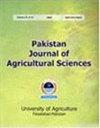氯化物浸种提高棉花(棉)耐旱性
IF 0.6
4区 农林科学
Q3 AGRICULTURE, MULTIDISCIPLINARY
引用次数: 0
摘要
采用完全随机设计、3个重复的因子试验,研究播前种子处理(PIX)对沙燕棉花生理特性和抗旱性的影响。在这项研究中,在盆栽之前,种子最初暴露于两种剂量的生长调节激素氯化物,包括5和10克/升和对照。植株出苗后,按土壤田容量(FC)、25%、50%和100%三种灌溉水平分别进行6周的干处理,观察植株生长指标、抗氧化酶活性、过氧化氢和丙二醛含量以及脱落酸和内源赤霉素两种激素的变化。本研究结果表明,在1%水平下,PIX催种和干旱×播前处理互作对各生理性状的影响均显著。结果表明,与对照相比,干旱胁迫(特别是严重干旱)降低了大部分生长指标和生理性状(根冠鲜干重、茎长、叶片鲜干重、叶面积、根过氧化活性、叶酚含量、赤霉素含量),仅增加了脱落酸含量(74%)、根径(38%)、根长(14%)、叶厚(15%)。播前PIX处理增加了干重(28%根和34%叶)、根厚(58%)和叶厚(96%),提高了过氧化氢酶(88%)、过氧化物酶(6%)活性和脱落酸含量(73%),降低了过氧化氢(17%)、丙二醛(20%)和赤霉素(40%)含量。在极端干旱胁迫下,与对照相比,施用PIX使叶片中酚类化合物的数量减少了44%。干旱胁迫与PIX的交互作用使根系赤霉素减少25%,叶片脱落酸增加183%。结果表明,PIX灌种可改善棉花在干旱条件下的生理生化反应本文章由计算机程序翻译,如有差异,请以英文原文为准。
Drought tolerance enhancment in cotton (Gossypium hirsutum L.) by mepiquate chloride seed priming
To study pre-sowing seed treatment (seed priming) of hormone Mepiquat chloride (MC) (PIX) on physiological properties and increase drought tolerance in cotton (Shayan cultivar), a factorial experiment was performed in a completely randomized design with 3 replications. In this research, the seeds were initially exposed to two doses of the growth-regulatory hormone mepiquat chloride, including 5 and 10 g/l and control before being planted in pots.After the emergence of the plant from the soil, dry treatments based on the soil field capacity (FC) at three levels of irrigation at 25, 50, and 100% of field capacity for six weeks are applied to them, and growth indices, the activity of antioxidant enzymes, amount of hydrogen peroxide and malondialdehyde as well as changes in the two hormones of abscisic acid and endogenous gibberellin was investigated. According to the results of this research, the effect of seed priming with PIX and the interaction of drought × pre-sowing seed treatment on all physiological traits were significant at the level of 1%. The results of experimental data showed that drought stress (especially severe drought) reduced most growth indicator and physiological traits (fresh and dry weight of root and shoot, shoot length, fresh and dry weight of leaf, leaf area, root peroxidation activity, leaf phenol content, amount of gibberellin ) and only increased abscisic acid content (74%), root diameter (38%), root length(14%), leaf thickness, (15%) compared to the control. pre-sowing seed treatment with PIX, while increasing the dry weight (28% roots and 34% leaves) and thickness roots (58%) and 96% leaves (96%), increased catalase (88%) and peroxidase (6%) activity and abscisic acid content (73%) of leaves, reduced hydrogen peroxide (17%), malondialdehyde (20%) of leaves, and gibberellin (40%) of roots. Under extreme drought stress, the application of PIX decreased the amount of phenolic compounds in leaves by 44% as compared to the control. The interplay of drought stress × PIX decreased root gibberellin by 25% and raised leaf abscisic acid by 183%. According to the study results, seed priming with PIX improved the physiological and biochemical responses of cotton under drought conditions
求助全文
通过发布文献求助,成功后即可免费获取论文全文。
去求助
来源期刊

Pakistan Journal of Agricultural Sciences
AGRICULTURE, MULTIDISCIPLINARY-
CiteScore
1.80
自引率
25.00%
发文量
18
审稿时长
6-12 weeks
期刊介绍:
Pakistan Journal of Agricultural Sciences is published in English four times a year. The journal publishes original articles on all aspects of agriculture and allied fields.
 求助内容:
求助内容: 应助结果提醒方式:
应助结果提醒方式:


